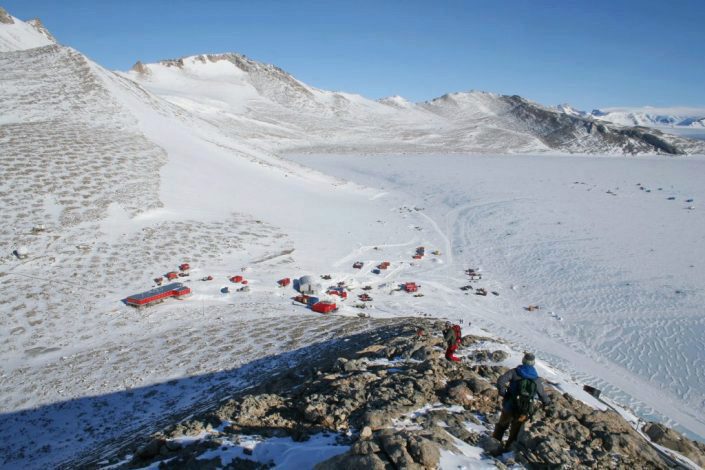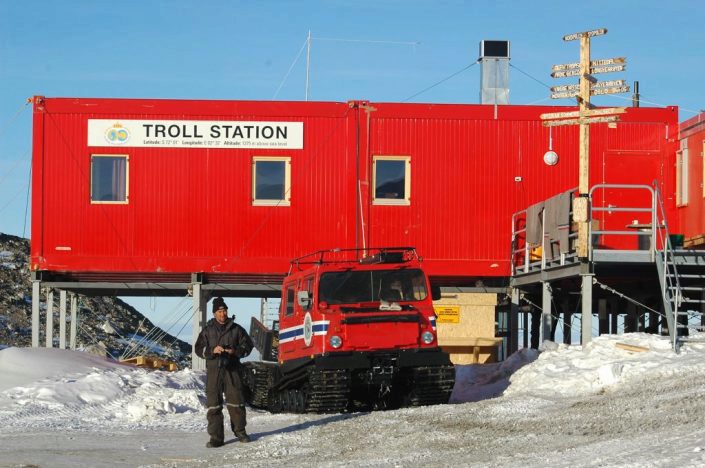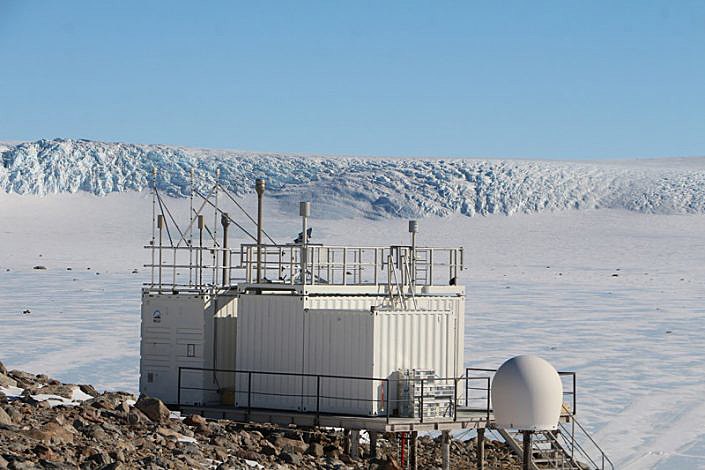Troll is located around 235 km from the coast, at Jutulsessen in Dronning Maud Land, a central area for Norwegian research in Antarctica.
The station is manned all the year round. It can accommodate six people in the Antarctic winter and many more in summer.
Research at the station
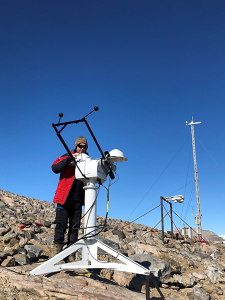
Radiation station with sun-tracker. Photo: Christina A. Pedersen / Norwegian Polar Institute
Meteorology
Standard automatic meteorological measurements are taken in both the Troll station area and on the blue ice near the airstrip, 7 km north of the station. The measurements at the airstrip are more representative of the area from a climatological perspective, while the measurements at the station are supplemented with manual observations three times a day. The measurements are used both operationally for weather forecasts and climatologically. Historic weather data is available via the Norwegian Meteorological Institute’s eklima database.
Radiation
The Norwegian Polar Institute is developing a radiation station with measurements that meet the demands stipulated by the global Baseline Surface Radiation Network (BSRN). Insolation and radiation from sunlight and infrared light, and the processes that affect these, are extremely important in determining whether or not the snow surfaces in the area are melting. These measurements, along with continuous cloud measurements, are used to monitor such processes.
Wildlife
The nearby nunatak Svarthamaren, some 100 kilometres east of Troll, is home to the world’s largest colony of Antarctic petrels. Several pairs of snow petrels and Antarctic skuas are also found here. Researchers led by ornithologists from the Norwegian Polar Institute visit the area annually to study the population, adaptation to environmental changes and strategies for nest-building. Petrels live on krill in the marine environment, several hundred kilometres from Svarthamaren. In recent times, the number of pairs has declined sharply, with a reduction of 90 per cent over the last 20 years.
Glaciology
The Polar Institute’s glaciologists are currently involved in a number of projects in Dronning Maud Land: MADICE is investigating how the coastal region of Dronning Maud Land has changed over the last thousand years by examining drifting ice shelves and ice rises. ICE Rises and POLARGAP are other glaciological projects from the Polar Institute with a large fieldwork component working out of Troll. In 2018, the Polar Institute led a geological expedition aimed at re-mapping Jutulsessen and nearby nunataks. In addition to the mapping work, another goal is to contribute new research that will increase understanding of Dronning Maud Land’s geological development, focusing on metamorphic, structural and geochronological studies.
Atmosphere
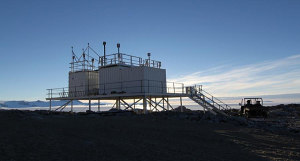
NILU’s atmospheric observatory on Trollhaugen. Photo: Wenke Aas, NILU
An atmospheric observatory run by NILU is located on Trollhaugen, 1,533 metres above sea level and 1 km east of the Troll research station. The work at the observatory includes characterising the composition of the atmosphere, measuring seasonal and yearly variations in the air masses and studying the transport of air pollution to the area. In addition, the observations are helping to interpret the trace element analyses of ice core specimens. The following components are measured: CO and greenhouse gases, the properties of aerosols, persistent organic pollutants (POPs), hydrocarbons, mercury, ozone and UV radiation. A large air sample is also taken every six months, contributing to an air archive for future analyses of new components and issues. The measurements were initially taken in 2007 closer to the station area, but were moved to Trollhaugen in 2014.
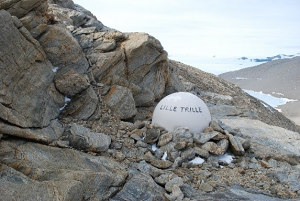
NORSARs seismometer on Nonshøgda. Photo: Christina A. Pedersen / Norwegian Polar Institute
Seismology
Since 2012, NORSAR has had a broadband seismometer located at Troll that can measure seismic activity (earthquakes etc.) both in the vicinity of the station and globally.
Seismology can also be used as a tool for studying cryospheric processes, and together with glaciologists from the Polar Institute, researchers at NORSAR have been examining the potential to track icebergs along the coast of Dronning Maud Land using data from the seismic station at Troll.
Ionosphere and space weather
The University of Oslo is currently establishing instrumentation for automatic measurements of the ionosphere and space weather. During the 2017/2018 season, an instrument was installed that continuously measures scintillations and electron density in the ionosphere. Furthermore, during the 2018/2019 season, an All Sky Imager will be established at the station to observe the Southern lights.
International research collaboration
Troll also facilitates international research collaboration, and in recent years the station has served as a base for microbiologists and geologists from South African universities, as well as a glacial geological project from Japan.
Activity on Troll
Those who plan activities at Troll must submit a notification to the Norwegian Polar Institute, who has roles as an authority exerciser, area manager and service provider, no later than one year before start-up.
Services provided at Troll
- Support for research
- Leasing of field equipment and personnel
- Board and lodging
- Transport and storage facilities
- Construction and services including leasing of construction machinery
- Personnel within most technical construction trades
- Workshop and technical assistance
- Medical assistance
Research requests
Research requests are taken to be requests from scientific institutions that wish
- to make use of the Norwegian Polar Institute’s services as described above to/from/around/at the Troll research station or its environs, or
- to use Troll as a base for installing instruments within the Troll land-use plan area, or
- a combination of these
In cases where the Norwegian Polar Institute is able to assist in accordance with the request, a written agreement on this will be signed.
Land use at Troll
As the operations manager, the Norwegian Polar Institute must ensure that the total level of activity, the future infrastructure development and land use at Troll is kept within a framework that takes appropriate account of research, the environment and the capacity of the basic infrastructure. The Norwegian Polar Institute is therefore responsible for approving all infrastructure established at Troll and thereby preventing unnecessary resource use, detrimental land use and unnecessary impacts on the surroundings.
As a basis for administrating land use at Troll, a land use plan has been drawn up. All establishment of new infrastructure?, and expansion of or significant change to existing infrastructure at Troll must take place in accordance with the guidelines set out in the land-use plan and its associated text section. All basic infrastructure? at Troll shall be owned by the Norwegian Polar Institute or Statsbygg (the Norwegian Directorate of Public Construction and Property). No other actors may establish or own such basic infrastructure.
Any request to establish, expand or change infrastructure within the area of the land-use plan must be notified to the Norwegian Polar Institute at least one year before start-up.
Land use is viewed in the light of the total level of activity, and certain other concerns must be taken into account. Before notification of the establishment of new activity or expansion or significant change to existing land use is sent to the Norwegian Polar Institute, the party responsible must therefore clarify with other actors at Troll whether the initiative may conflict with another activity. The Norwegian Polar Institute will assess the consequences for its own activities when the notification is received. Advance clarification with the Norwegian Polar Institute itself is therefore not required.
A land-use permit at Troll may not be transferred, leased or otherwise entrusted to another party, either in whole or in part.
Contact

Jon Hugo Strømseng
Section leader

